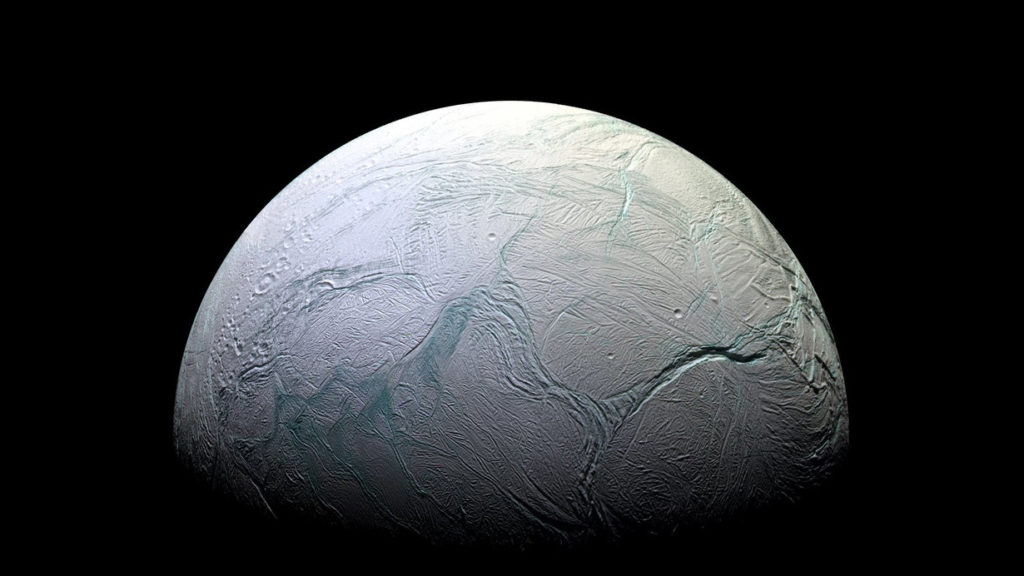The Cassini spacecraft in orbit around Saturn has made a startling discovery on the moon Enceladus. The molecule hydrogen (H2) was found in a series of close fly-bys through a continuous jet of icy particles called a plume shooting hundreds of miles into space from cracks in the moon’s surface. Hydrogen is candy to potential bacteria that could be living in that ocean and further indicates that active chemical reactions between water and rocks are happening in the ocean. Does this mean that there is life? No. Does that mean that if life were to exist, it could survive? Yes.
Saturn’s little moon Enceladus has surprised everyone. Enceladus is a tiny moon (310 miles in diameter) so was expected to be a cold, inactive world. After a seven year transit, Cassini arrived at Saturn in 2004, and in 2005, the spacecraft discovered plumes of mostly water coming out vigorously from the moon’s south pole. This was a significant discovery because this meant that below the moon’s ice-shell lies an ocean, much like on a (much larger) moon of Jupiter called Europa. On Earth, wherever we find water, we find life. Could this be true beyond our home planet?
For life to exist, a few requirements are needed. Broadly speaking, you need a liquid solvent, like water, and energy for food and warmth. The plumes are likely powered by energy from the ocean tides that Saturn itself imposes on the moon, flexing it as the moon orbits the planet.
The discovery of hydrogen is significant because it implies another source warmth, as well as food. While there are several ways hydrogen could be generated, the most likely scenario happening on Enceladus is through a process called ‘serpentinization’, where certain types of rocks react with water and produce hydrogen as a by-product. Serpentinization is named after the texture that the rock develops, which looks like snake skin. This process happens on Earth, and is thought to have also occurred on Mars. In fact, the most famous site of active serpentinization on Earth is called “Lost City” about a mile under water close to the Atlantic spreading ridge – the underwater mountainous spine the results from the continuous opening of the Atlantic ocean. What is amazing about serpentinization is that the chemical reaction produces heat energy. This energy causes the rocks to swell, creating cracks through which more water can infiltrate and continue making more hydrogen with new rock.
Hydrogen is the most basic food source for life. Some bacteria found at “Lost City” combine hydrogen with carbon dioxide that is dissolved in the water to give them energy and make methane as a byproduct. The authors of the hydrogen-discovery study calculate that indeed the environment on Enceladus could support such bacteria.
So Enceladus has everything life needs: water, warmth, and food. Broadly speaking, this is quite exciting, because this means that environments that can support life as we know it are confirmed to not be limited to Earth. Nonetheless, there is some cause for concern, because if life was present, it would be gobbling up all that food, with very little reaching the spacecraft. Hydrogen is like free pizza. The fact that you can find free pizza in a university building means that there are no students around to eat it.
The Cassini spacecraft was launched in 1997 to study the Saturnian system. It was originally meant to study the planet itself, its moons, and especially its moon Titan. Titan is particularly interesting because it has an atmosphere, while the other moons do not. NASA now has a new mission in the works called the Europa Clipper, which will study the moons of Saturn. This discovery on Enceladus will likely get people even more excited about this mission. Here’s to the hope that it actually flies and potentially answers one of the most fundamental question of Astrobiology: are we alone?


